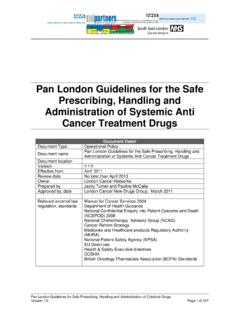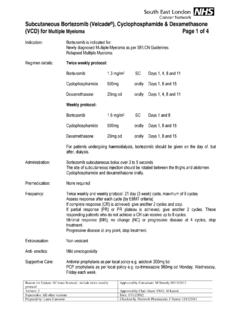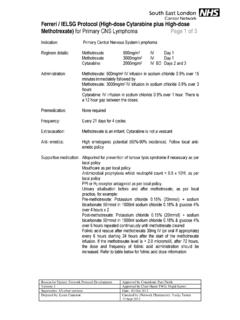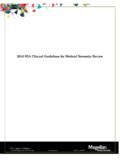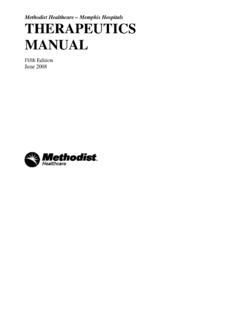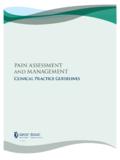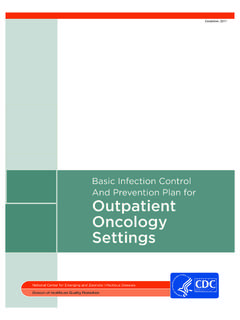Transcription of Acute Oncology Services Clinical Guidelines
1 LCA Acute Oncology Clinical Guidelines September 2013 LCA Acute Oncology Clinical Guidelines 2 Contents Introduction .. 3 Executive Summary .. 5 1 Allergy and Anaphylaxis .. 8 2 Ascites (Malignant) .. 10 3 Central Venous Access Device 12 4 Diarrhoea: Chemotherapy and Radiotherapy Induced .. 16 5 Extravasation of Chemotherapy .. 20 6 Hypercalcaemia of Malignancy .. 23 7 Hypomagnesaemia .. 26 8 Lymphangitic Carcinomatosis .. 28 9 Metastatic Spinal Cord Compression .. 30 10 Mucositis .. 38 11 Nausea and Vomiting .. 41 12 Neutropenic Sepsis .. 47 13 Pericardial Effusion (Malignant) .. 48 14 Radiotherapy Induced Complications.
2 49 15 Raised Intracranial Pressure/Central Nervous System (CNS) Space Occupying Lesions .. 53 16 Superior Vena Cava Obstruction .. 55 57 INTRODUCTION 3 Introduction Acute Oncology focuses on the management of patients with complications of their cancer diagnosis and treatment, and the management of patients with an Acute new cancer diagnosis. Although patients are often treated in specialist Oncology centres, they are more likely to present to their local hospital when Acute problems develop. In 2008, the National Confidential Enquiry into Patient Outcome and Death (NCEPOD) report, Systemic Anti-Cancer Therapy: For better, for worse?
3 , looked into deaths within 30 days of receiving systemic anti-cancer therapy and identified significant concerns regarding the quality and safety of patient care both at an organisational and a Clinical level. Delays in admission, delays in prescribing and administering antibiotics, lack of assessment by senior staff, poor communication between teams, lack of documentation, lack of Oncology input and lack of clear policies were just a few of the concerns identified. The ensuing National Chemotherapy Advisory Group report, Chemotherapy Services in England: Ensuring quality and safety (2010), highlighted the need for an Acute Oncology service (AOS) in every hospital.
4 The National Cancer Action Team Acute Oncology Measures (2011) stipulate that Acute Oncology protocols should be available in the chemotherapy and radiotherapy units, A&E departments, Acute medical admissions wards and Oncology in-patient wards. Although there is significant consensus across the UK about the management of Oncology emergencies, no national Guidelines are available. Prior to the establishment of the London Cancer Alliance (LCA), Acute Oncology within west and south London was organised between three cancer networks north west, south west and south east. Each developed its own Acute Oncology Clinical Guidelines which, although different, covered the same subjects and comprised similar information.
5 The LCA Acute Oncology Clinical Guidelines have been written by representatives from each of these cancer networks and agreed by representatives of all 17 provider organisations across the LCA. They provide evidence-based Clinical information and protocols while allowing sufficient flexibility to reflect good local practice. They include information from recently published national Guidelines , such as the National Institute for Health and Care Excellence (NICE) Clinical guideline on neutropenic sepsis (CG15). They also include information on the assessment and management of metastatic spinal cord compression (MSCC) aimed particularly at Acute admission through A&E.
6 The LCA is in the process of developing a more comprehensive LCA-wide care pathway for the diagnosis, treatment, rehabilitation and ongoing care of patients with MSCC. The LCA Acute Oncology Clinical Guidelines are designed to be used by all healthcare professionals in provider organisations across the LCA who are involved in the care of the cancer patient. They have been developed to take into account the wide range of Clinical experience of the user and the different Clinical settings in which they work. The Guidelines are intended to assist in the initial assessment, investigation and management of patients. They are not a substitute for specialist Oncology input, and must be used in conjunction with existing protocols, such as local microbiological Guidelines .
7 Adoption of the LCA Acute Oncology Clinical Guidelines will allow LCA Acute Oncology Clinical Guidelines 4 widespread implementation of up-to-date and evidence-based management of Oncology patients, and will assist in the provision of a consistently high standard of care across the LCA. All provider organisations are expected to be able to provide the standard of care detailed in these Guidelines . For specific areas where it is anticipated that local facilities may not exist (for example out-of-hours magnetic resonance imaging), protocols are given for the transfer to specialist Oncology centres. In many other areas of the Guidelines there is a limited or absent evidence base to support decision making.
8 In these situations Clinical consensus has been used to agree best practice. I hope these Guidelines are helpful. We welcome all feedback and suggestions, and these can be sent to me at the email address below. I would like to thank the LCA Acute Oncology Services Pathway Group for its help in writing this document. Dr Tom Newsom-Davis Consultant Oncologist Chelsea and Westminster Hospital NHS Foundation Trust Chair, LCA Acute Oncology Services Pathway Group EXECUTIVE SUMMARY 5 Executive Summary The LCA Acute Oncology Clinical Guidelines have been developed to assist in the initial assessment, investigation and management of patients who present with Oncology emergencies as set out in Appendix 3 of the National Cancer Peer Review Programme Manual for Cancer Services : Acute Oncology (version ).
9 This includes major presentations such as metastatic spinal cord compression, which is subject to recent National Institute for Health and Care Excellence (NICE) Clinical guidance, as well as less well publicised conditions such as electrolyte disturbances, gastrointestinal toxicities and the Acute management of effusions. Each topic is covered in a separate section, listed in alphabetical order, with an emphasis on succinct, unambiguous advice and guidance. Each section starts with a brief summary of the condition to allow understanding of its context and importance, followed by the expected Clinical presentations. A range of investigations is suggested, with the understanding that these will be tailored to individual cases.
10 In most instances the subsequent management protocols mention generic drugs as opposed to specific brands in order to allow flexibility. At all times, local Guidelines should be adhered to and, where relevant, they should take priority over this document. Section 1 covers allergy and anaphylaxis, which may occur in the minutes or hours following treatment. It highlights the assessments required prior to treatment, as well as the signs, symptoms and treatments associated with allergies and anaphylaxis. The management of malignant ascites, most commonly seen in patients with a known diagnosis of ovarian or gastrointestinal cancer is covered in section 2.





